How To Identify Old Indian Pottery
Pottery holds a significant place in Indian history and culture. The art of creating pottery has evolved over centuries, leaving behind a rich heritage of ancient artifacts. Identifying old Indian pottery can be a fascinating endeavor, connecting us to the past. In this article, we will explore the various aspects of Indian pottery and provide insights on how to identify these valuable treasures.
1. Introduction
Indian pottery carries immense historical and cultural value. It reflects the artistic skills, traditions, and lifestyles of different eras in Indian civilization. By examining the clay, design, and techniques used, one can determine the age and origin of pottery pieces.
2. Understanding Indian Pottery
2.1 Historical Significance
Indian pottery dates back thousands of years and has played a crucial role in documenting the country’s history. From the ancient Indus Valley Civilization to various regional dynasties, pottery has served as a medium of artistic expression and functional utility.
2.2 Types of Indian Pottery
India boasts a diverse range of pottery styles due to its regional variations and cultural diversity. Some prominent types include terracotta, redware, blackware, greyware, and celadon. Each type showcases distinct characteristics in terms of clay composition, firing techniques, and decorative patterns.
3. Identifying Old Indian Pottery
When it comes to identifying old Indian pottery, several factors come into play. By examining the clay, analyzing the design, and considering the technique used, one can gain valuable insights into the age and authenticity of the piece.
3.1 Examining the Clay
The composition of clay can reveal important clues about the pottery’s age. Older pottery often uses traditional clay sources and may display signs of weathering or mineral deposits. By observing the color, texture, and consistency of the clay, experts can make informed judgments.
3.2 Analyzing the Design
The design elements present on pottery can offer significant hints about its origin and period. Intricate patterns, motifs, and symbols reflect the artistic styles prevalent during specific historical periods. Comparing the design with known examples from different time periods can aid in identification.
3.3 Considering the Technique
Different pottery techniques were employed during various periods in Indian history. These techniques include hand-building, wheel-throwing, slip-casting, and glazing. By examining the craftsmanship and technical aspects of a pottery piece, one can narrow down its age range.
4. Tools for Identification
Identifying old Indian pottery often requires specialized tools and techniques. These tools assist in closely examining the pottery and making informed judgments about its age and authenticity.
4.1 Magnifying Glass
A magnifying glass helps in scrutinizing intricate details and finer craftsmanship on the pottery’s surface. It enables the observer to identify brushstrokes, glaze imperfections, and even microscopic patterns that may indicate its age.
4.2 UV Light
Ultraviolet (UV) light can unveil hidden features that are not visible under normal light. Certain pottery glazes and pigments fluoresce under UV light, which can aid in distinguishing between authentic and reproduction pieces.
4.3 Carbon Dating
Carbon dating is a scientific technique used to determine the age of organic materials. In some cases, the pottery itself or organic matter found within it can be subjected to carbon dating. This method provides a precise estimation of the pottery’s age.
5. Research and Expertise
Identifying old Indian pottery may require additional research and expert guidance. Accessing available resources and seeking expert opinion can greatly enhance the accuracy of identification.
5.1 Museum Resources
Museums often house extensive collections of Indian pottery. Visiting museums and studying their displays can provide valuable insights into different pottery styles, techniques, and historical contexts. Museum curators and experts can offer guidance and share their knowledge.
5.2 Consulting Specialists
Specialists in Indian pottery can offer expert opinions and in-depth analysis. They possess a deep understanding of various pottery styles, historical periods, and techniques. Consulting with these specialists can help identify and authenticate old Indian pottery.
6. Preservation and Care
Once you have identified and acquired old Indian pottery, it is crucial to ensure its preservation and care for future generations to appreciate.
6.1 Handling and Display
Proper handling techniques, such as supporting the base and avoiding excessive pressure, are essential to prevent damage. Displaying pottery in controlled environments away from direct sunlight, extreme temperatures, and high humidity helps maintain its integrity.
6.2 Storage and Maintenance
When not on display, pottery should be stored in archival-quality materials to protect it from dust, moisture, and accidental breakage. Regular dusting and gentle cleaning using non-abrasive techniques can help preserve its appearance.
7. FAQs
Q1. Can I identify the age of Indian pottery based solely on its design?
A1. While design elements can provide valuable insights, identifying the age of Indian pottery requires considering multiple factors such as clay composition, technique, and historical context.
Q2. Are there any online resources available for identifying Indian pottery?
A2. Yes, several websites and forums dedicated to Indian pottery provide information, images, and expert opinions that can assist in identification.
Q3. Can I use carbon dating to identify any pottery piece?
A3. Carbon dating is applicable to organic materials within the pottery or the pottery itself. However, not all pottery may contain suitable organic matter for this dating method.
Q4. Is it necessary to consult specialists for pottery identification?
A4. While not mandatory, consulting specialists can significantly improve the accuracy of pottery identification, especially for rare or unique pieces.
Q5. What are the common causes of damage to old Indian pottery?
A5. Common causes of damage include improper handling, exposure to extreme temperatures and humidity, direct sunlight, and accidents. Proper care and preservation techniques can mitigate these risks.
8. Conclusion
Identifying old Indian pottery allows us to delve into the rich cultural heritage of the subcontinent. By understanding the clay, design, and techniques employed, we can unlock the secrets held within these ancient artifacts.
Utilizing tools, conducting research, and seeking expert guidance are vital in the process. Remember to preserve and care for these treasures, ensuring they continue to be appreciated for generations to come.






